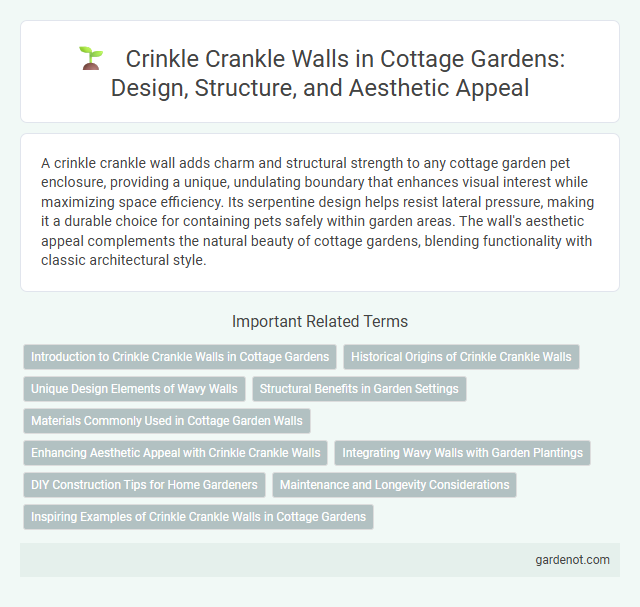A crinkle crankle wall adds charm and structural strength to any cottage garden pet enclosure, providing a unique, undulating boundary that enhances visual interest while maximizing space efficiency. Its serpentine design helps resist lateral pressure, making it a durable choice for containing pets safely within garden areas. The wall's aesthetic appeal complements the natural beauty of cottage gardens, blending functionality with classic architectural style.
Introduction to Crinkle Crankle Walls in Cottage Gardens
Crinkle crankle walls, characterized by their serpentine or wavy design, are a distinctive feature in traditional cottage gardens that provide both structural strength and aesthetic appeal. These walls maximize stability by distributing pressure evenly, allowing them to be thinner than straight walls while supporting climbing plants such as roses and vines. Originating in East Anglia, England, crinkle crankle walls enhance garden charm and create microclimates beneficial for delicate flora in cottage garden settings.
Historical Origins of Crinkle Crankle Walls
Crinkle crankle walls, also known as serpentine walls, originated in Suffolk, England, during the 18th century as an innovative solution to conserve materials while providing structural stability through their distinctive curved design. These walls efficiently use fewer bricks than straight walls due to their wave-like shape, which resists lateral pressure without the need for buttresses, making them ideal for supporting fruit trees in cottage gardens. Historical records highlight their prevalence in Georgian architecture and rural landscapes, reflecting a blend of practicality and aesthetic charm in traditional English gardening.
Unique Design Elements of Wavy Walls
Crinkle crankle walls feature a distinctive serpentine or wavy design that enhances structural stability by distributing lateral pressure evenly, allowing for thinner construction without compromising strength. Their alternating convex and concave curves not only create visual interest but also maximize sun exposure for plants growing along the wall, promoting healthier gardens. This unique design element blends both form and function, making crinkle crankle walls a practical and aesthetic asset in cottage garden landscapes.
Structural Benefits in Garden Settings
Crinkle crankle walls in cottage gardens provide enhanced structural stability due to their serpentine shape, which requires fewer materials compared to straight walls while resisting lateral pressure more effectively. This design allows for thinner walls without compromising strength, optimizing space and resources in garden layouts. Their undulating form also supports climbing plants, integrating structural function with aesthetic and horticultural benefits.
Materials Commonly Used in Cottage Garden Walls
Crinkle crankle walls in cottage gardens are traditionally constructed using red brick, which provides both durability and a warm, rustic aesthetic. The sinuously curved design enhances structural strength, allowing the use of thinner, less material-intensive walls compared to straight walls. Lime mortar is commonly used for binding, promoting breathability and flexibility essential for the wall's longevity in varied weather conditions.
Enhancing Aesthetic Appeal with Crinkle Crankle Walls
Crinkle crankle walls, characterized by their serpentine design, enhance the aesthetic appeal of cottage gardens by adding visual interest and architectural charm. Their undulating shape creates dynamic shadows and texture, breaking the monotony of straight boundaries and providing a unique backdrop for climbing plants and flowers. Incorporating crinkle crankle walls elevates garden design, blending functionality with artistic elegance to transform outdoor spaces into picturesque retreats.
Integrating Wavy Walls with Garden Plantings
Crinkle crankle walls enhance cottage gardens by providing both structural interest and functional planting support, their serpentine shape maximizing stability while creating microclimates ideal for heat-loving plants such as espaliered fruit trees and climbing roses. Integrating these wavy walls with garden plantings encourages vertical growth, optimizes space, and boosts biodiversity by offering habitats for pollinators and beneficial insects. The undulating design captures sunlight efficiently, feeding adjacent plants and enriching the cottage garden's natural aesthetic and productivity.
DIY Construction Tips for Home Gardeners
Crinkle crankle walls feature a distinctive serpentine design that provides structural strength while using fewer materials, making them ideal for DIY home gardeners. When constructing these walls, start by accurately measuring and planning the curves to ensure stability and uniformity, using bricks or stones laid in a consistent pattern. Incorporate a strong foundation and consider reinforcing with steel rods to enhance durability in your cottage garden setting.
Maintenance and Longevity Considerations
Crinkle crankle walls require minimal maintenance due to their curved design, which distributes weight evenly and reduces stress on materials, enhancing structural stability. Regular inspections for cracks and repointing mortar joints every few years help prevent water ingress, preserving the wall's integrity. Using durable materials like brick or stone and ensuring proper drainage around the base significantly extend the wall's longevity in a cottage garden setting.
Inspiring Examples of Crinkle Crankle Walls in Cottage Gardens
Crinkle crankle walls, with their distinctive serpentine design, maximize structural strength while adding aesthetic charm to cottage gardens. Notable inspiring examples include the historic Suffolk walls in England, which gently weave through garden beds, creating natural windbreaks and unique visual appeal. These walls not only enhance plant protection but also serve as artistic focal points that blend seamlessly with rustic garden landscapes.
Crinkle crankle wall Infographic

 gardenot.com
gardenot.com